 Jandiala Sher Khan is the final resting place of eminent sufi poet Syed Waris Ali Shah.
Jandiala Sher Khan is the final resting place of eminent sufi poet Syed Waris Ali Shah.
Located about fourteen kilometer northwest of Sheikhupura at the intersection of Sheikhupura-Vanike and Gujranwala-Chuharkana roads, the town is rather an unremarkable place. For about two centuries the author of magnum opus Heer-Ranjha has lied here in the local cemetery in an unassuming tomb.
Even though visited by thousands of fans and devotees annually, for long the grave site had gained very little attention from the official authorities. That is till 1975 when under the pressure of town folks and other lovers of his literary work the government of Punjab province of Pakistan decided to build a proper mausoleum complex in the honor of this great poet.
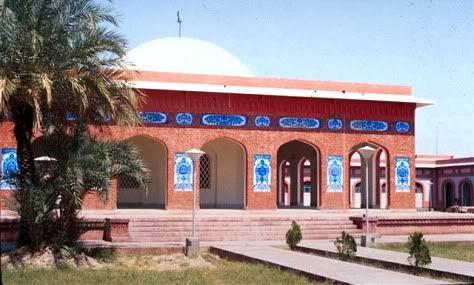
Jandiala Sher Khan is also the birth place of Waris Shah. In year 1584 Emperor Akbar had moved his capital to Lahore and as favorite hunting place of Prince Salim the heavily wooded area of Sheikhupura had gained some prominence.
 Most likely the family had settled in the area during the reigns of Emperor Akbar or his son Emperor Jahangir. Waris Shah was born to his father Syed Gul Sher Shah but the exact date of his birth is not clear. Various sources place his year of birth anywhere between 1706 and 1730. Similarly his year of death is also stated to be somewhere between 1780 and 1798. But there is agreement among historians that Waris Shah lived a long life and ultimately died in his family village. According to most estimates he died at the age of 92.
Most likely the family had settled in the area during the reigns of Emperor Akbar or his son Emperor Jahangir. Waris Shah was born to his father Syed Gul Sher Shah but the exact date of his birth is not clear. Various sources place his year of birth anywhere between 1706 and 1730. Similarly his year of death is also stated to be somewhere between 1780 and 1798. But there is agreement among historians that Waris Shah lived a long life and ultimately died in his family village. According to most estimates he died at the age of 92.
Waris Shah wrote his love epic near about year 1766-67. During his lifetime Punjab was ransacked by Nadir Shah Afshar in 1739. In 1747 Ahmad Shah Abdali annexed Punjab to his Kandahar based first Afghan kingdom. And in year 1780 Ranjit Singh wrestled Punjab away from the grandson of Abdali.
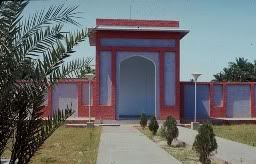 Waris Shah must have seen the fall of the Mughals and the ensuing anarchy; the rise of Durrani Afghans; and Sikha Shahi in Punjab as there are numerous references to the historic events of eighteenth century in his work. It is not clear by whom and when the tomb of Waris Shah was first constructed. However Waris Shah because of the popularity of ‘Heer’ and his sufi lifestyle had gained fame and admiration even during his life. After his death his grave site became a place of pilgrimage and ever since then during the month of July his death anniversary ‘urs’ is celebrated as town festival. Construction of mausoleum complex at the tomb has made visit to the site a pleasant experience.
Waris Shah must have seen the fall of the Mughals and the ensuing anarchy; the rise of Durrani Afghans; and Sikha Shahi in Punjab as there are numerous references to the historic events of eighteenth century in his work. It is not clear by whom and when the tomb of Waris Shah was first constructed. However Waris Shah because of the popularity of ‘Heer’ and his sufi lifestyle had gained fame and admiration even during his life. After his death his grave site became a place of pilgrimage and ever since then during the month of July his death anniversary ‘urs’ is celebrated as town festival. Construction of mausoleum complex at the tomb has made visit to the site a pleasant experience.
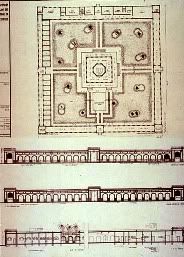 In year 1975 a Waris Shah Mausoleum Committee was appointed to oversee the planning and construction of the new complex. Architect Abdul Rashid was entrusted with the design work. The complex is located along Kasha Road and consists of an 83×83 meter cemetery garden on one side and an open-air theater on the other side of the road. The domed octagonal mausoleum is housed within a rectangular pavilion built on a centered 24×24 meter elevated platform with decorated stairs on all four sides. The square shaped garden is enclosed on all four sides by high decorative brick walls with arched entrance in the middle of each side. Along two of the four walls are covered corridors with screens and arches. Against other two walls are areas dedicated for house keeping and comfort facilities.
In year 1975 a Waris Shah Mausoleum Committee was appointed to oversee the planning and construction of the new complex. Architect Abdul Rashid was entrusted with the design work. The complex is located along Kasha Road and consists of an 83×83 meter cemetery garden on one side and an open-air theater on the other side of the road. The domed octagonal mausoleum is housed within a rectangular pavilion built on a centered 24×24 meter elevated platform with decorated stairs on all four sides. The square shaped garden is enclosed on all four sides by high decorative brick walls with arched entrance in the middle of each side. Along two of the four walls are covered corridors with screens and arches. Against other two walls are areas dedicated for house keeping and comfort facilities.
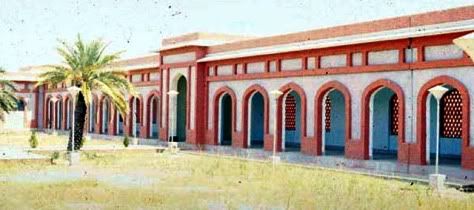
An outside road along the garden walls facilitates entrance from all four directions with theater side serving as the main entrance. The three side-entrances connect to the center via symmetrical duel walkways while the main entrance leads to the pavilion around a large fountain set in a reflective pool. The grassy courtyard and the walkways are graced with well placed palm and pine trees. The open-air theater has a stage, two backstage rooms and a covered orchestra terrace. The audience seating is done on make shift basis. Recently authorities have added some visitor comfort facilities to the overall complex.
http://www.youtube.com/watch?v=CsA1iKduWTA
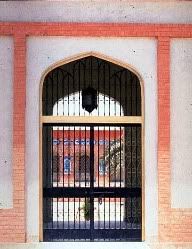 The mausoleum complex was completed and opened to the public in 1978. Even though build in late twentieth century the architecture of the Waris Shah Mausoleum is set in the sixteenth & seventeenth century Mughal style seen in various historical monuments in and around Lahore. The layout of the walled garden replicates Shalamar Gardens in Lahore. The outer wall corridors are similar to those at the Badshahi Mosque. The duel walkways, rectangular elevated platform with steps, and main pavilion remind of those mausoleums of Emperor Jahangir, his wife Empress Noor Jahan and her brother Asif Jah.
The mausoleum complex was completed and opened to the public in 1978. Even though build in late twentieth century the architecture of the Waris Shah Mausoleum is set in the sixteenth & seventeenth century Mughal style seen in various historical monuments in and around Lahore. The layout of the walled garden replicates Shalamar Gardens in Lahore. The outer wall corridors are similar to those at the Badshahi Mosque. The duel walkways, rectangular elevated platform with steps, and main pavilion remind of those mausoleums of Emperor Jahangir, his wife Empress Noor Jahan and her brother Asif Jah.
 The construction is mostly out of red brick and white plaster following the revived ‘Lahore School’ of late. The use of decorative blue & white tiles is borrowed from an earlier pre-Mughal ‘Tughlic Style’ common in the Multan area historic monuments and thus seems a bit out of place. Nevertheless the overall ensemble is very pleasant and proportional. Seeing how that Waris Shah lived in the eighteenth century and wrote of a love tale even two centuries before that, the Mughal style mausoleum is a befitting tribute to this literary giant.
The construction is mostly out of red brick and white plaster following the revived ‘Lahore School’ of late. The use of decorative blue & white tiles is borrowed from an earlier pre-Mughal ‘Tughlic Style’ common in the Multan area historic monuments and thus seems a bit out of place. Nevertheless the overall ensemble is very pleasant and proportional. Seeing how that Waris Shah lived in the eighteenth century and wrote of a love tale even two centuries before that, the Mughal style mausoleum is a befitting tribute to this literary giant.
Following is a satellite image of the Waris Shah Mausoleum complex.

The author is a Ravian and Civil & Geotechnical Engineer.



















































Did anyone wondered about the portrait of Waris Shah, how it evolved to take the present form, which is now considered as the most popularly accepted picture of Waris Shah. Secondly, do we have any information on the biography of Waris Shah, presumably written by his brother, Qasim Shah? thanks.